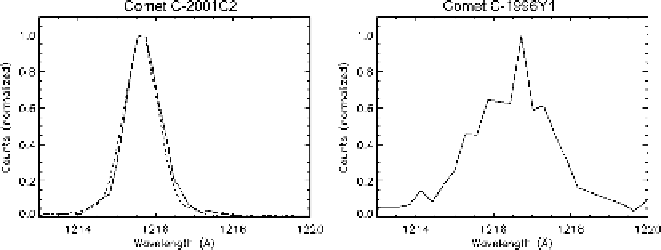Geoscience Reference
In-Depth Information
Fig. 2. Normalized cometary Ly
α
profiles for the C/2001 C2 (left panel, solid line) and
the C/1996 Y1 (right panel, adapted from Ref. 3) sungrazers, respectively, at 3.6 and
5.3 R
. In the left panel the cometary profile is compared to the average coronal profile
(dashed line).
transfer with coronal protons. This is in contrast to the normal comets, in
which the first generation neutrals typically dominate due to the smaller
velocity of the comet relative to the Sun.
6
Because of the small momentum
transfer in the charge exchange process,
11
the secondary H atoms have the
same velocity distribution of the coronal atoms. Following the latter con-
clusion, we should expect that the orientation of the Ly
α
tails match the
anti-Sun direction, because of the nearly radial direction of the outflowing
solar wind at 4.56 and 4.98 R
. On the contrary, as mentioned in Sec. 2,
the observed Ly
α
tails are oriented along the cometary orbital path. This
can be explained as follows: as we better discuss in the next section, from
the variation with time of the Ly
α
cometary intensity it has been possible
to evaluate the characteristic times for the charge exchange and ionization
processes. It turns out that cometary H atoms formed by charge exchange
have a short lifetime (on the order of 500 and 1,000 s, respectively, for the
C/2000 C6 and C/2001 C2 sungrazers observed at 4.56 and 4.98 R
). This
may explain the orbital orientation of these tails: because of the short H
atoms lifetime, before being ionized they covered path too short to align
the observed tail with the local outflow velocity.
In Sec. 4 we discuss sungrazers parameters derived from the observed
Ly
α
emission.
4. Estimate of Sungrazers Outgassing Rate and
Nucleus Size
The number of neutrals moving with the comet
N
coma
is proportional to
the unknown outgassing rate
N
(where
N
is the number of neutrals per









